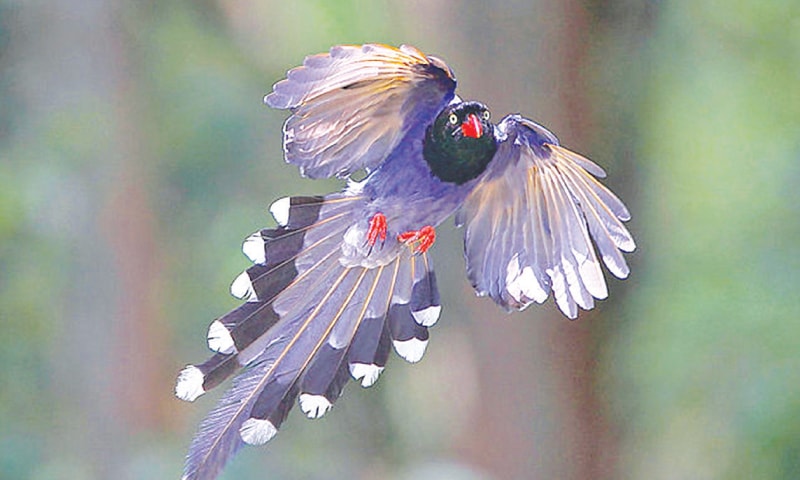Engrossed in our tedious life and daily tasks, we hardly notice the beauty that is present all around us, such as in the trees, plants, flowers, animals and the creatures flying above us — yes, I am talking about the beautiful, magnificent birds.
Birds come in a breathtaking number of shapes, sizes and colours, but some really stand out from the rest of the crowd. Whether it’s growing specialised beaks, crowns or making record-setting flights, birds find ways to make us more amazed by their awesome beauty. That also includes birds that have evolved particularly striking tails.
Whether extra long or just extra weird, the tail of a bird is the feature that draws the most attention towards it. Today we will explore the spectacular tails that some birds possess, many of which most of us have not seen.

Long-tailed widowbird
These South African birds are named for their almost all black colouring and, of course, their extremely long tail. Between six and eight of their tail feathers grow to more than 20 inches — about three times the length of the bird’s body — in order to show off the health and fitness of the male in the species.
Researchers have found that male birds with longer tails are more popular.

Taiwan magpie
Also called the formosan blue magpie or the “long-tailed mountain lady”, this amazing bird is a member of the crow family. However, it is much more colourful than its cousins. This fascinating blue crow is unafraid of people.
They are usually found in groups of six or more, gliding and shuttling in the woods. Similar to other members of the crow family, they have a raucous call which is described as a high-pitched cackling chatter, “kyak-kyak-kyak-kyak”.
They are well-known scavengers and omnivores. Their diet includes snakes, rodents, small insects, plants, fruits and seeds. Wild figs and papayas are their favourites. They are known to store leftovers on the ground and cover them with leaves for future retrievals.
The Taiwan blue magpie is monogamous. Females incubate eggs while males help out with nest-building and feeding. Taiwan blue magpies have strong nest defence behaviour and will attack intruders mercilessly until they retreat.

Ribbon-tailed astrapia
As far as excessively long tail feathers, the ribbon-tailed astrapia gives the long-tailed widowbird a serious run for his money. This is a species of bird-of-paradise, many of which are famous for over-the-top plumage.
The males grow two extraordinarily long tail feathers. The two feathers can grow to more than three feet in length. In fact, the ribbon-tailed astrapia has the longest tail feathers in relation to body size of any bird.
Found in the western part of the central highlands of Papua New Guinea, the species is listed as near threatened in part because it is hunted for these very tail feathers.

Wilson’s bird-of-paradise
Afancy tail doesn’t have to be exceptionally long — it can also be exceptionally well styled. Such is the case with the tail feathers of the Wilson’s bird-of-paradise.
The unusual appearance of the bird, starting with its naked blue head, is made all the more interesting by the two violet tail feathers that curl in opposite directions. The bird was filmed in the wild for the first time as recently as 1996.

Greater bird-of-paradise
So many species of bird-of-paradise are all about the fancy feathers. Not to be outdone by anyone is the greater bird-of-paradise — a large bird that can be up to 43cm long. The male is maroon brown, with a yellow crown, dark emerald green throat and a blackish brown breast. It has large, yellow flank plumes, with a pair of long tail wires.
The female is maroon brown, with a darker head and a lighter belly and a yellow or white beak. These birds mainly eat fruits, seeds and small insects.

Red-billed streamertail
Even the smallest of bird species will do their best to show off with particularly fancy tails. The red-billed streamertail is one such bird and is also known as the scissor-tail hummingbird. The reason for the alternate name is obvious.
Males sport tail feathers that are six to seven inches long, while their bodies are only about 4.5 inches long. As the bird flies, the streamer-like tail feathers flow and make a humming sound. The species is the national bird of Jamaica.
Greater racket-tailed drongo
The spatuletail isn’t the only species with these racket-like tail feathers. The greater racket-tailed drongo is a medium-sized bird from Asia, and can easily be identified by its twirled rackets and in flight it can appear as if two large bees were chasing a black bird.
This bird species is aggressive and sometimes mob larger birds, especially when nesting. They are often active at dusk. Their calls are extremely varied and include monotonously repeated whistles, metallic and nasal sounds, as well as more complex notes and imitations of other birds.
They begin calling from as early as 4am in moonlight, often with a metallic tunk-tunk-tunk series. It is also said that they have an ability to accurately mimic alarm calls of other birds that are learnt through interactions in mixed-species flocks, which is quite unusual.

Marvellous spatuletail hummingbird
If the streamer tail seems fancy, it is nothing in front of the marvellous spatuletail hummingbird. This species sets a high bar when it comes to attention-grabbing feather designs, and it does a lot with just a little.
The males have just four tail feathers, two of which are elongated, cross over each other, and end in bright violet disks, or paddles. The feathers are used to show off to other birds.

Scissor-tailed flycatcher
Also known as Texas bird-of-paradise, both males and females have long tails, but those of females tend to be about 30 per cent shorter.
They generally like to perch out in the open, such as on barbed-wire fences. The scissor-tailed flycatcher can easily be spotted because of their dramatically long tails that also aid them in making acrobatic aerial moves while catching insects on the wing.

Resplendent quetzal
This beauty is found in the most southern parts of North America and in Central America. It is a key player in Mesoamerican mythology, and is the national bird of Guatemala.
The long tail feathers of the males can grow up to 26 inches. Mesoamerican rulers wore headdresses made from quetzal feathers, which were plucked from live birds, and then the birds were set free again because it was considered a crime to kill them. They were, and still are, held in very high regard.

Long-tailed paradise whydah
This sparrow-like species has a long, straight tail feathers that make it stand out anywhere. The species is brood parasitic, meaning that the females lay their eggs in the nests of a different bird species, the parents of which raise these impostor chicks often to the detriment or death of their own chicks.
The tail feathers of the males can grow to roughly three times their body length, but they only sport them during breeding season. Outside of breeding season, the males look practically identical to females.

Superb lyrebird
The superb lyrebird is aptly named, as its tail feathers are simply superb. It takes males approximately seven years to grow their tail to its full beauty.
To display its stunning feathers, the male of this Australian bird species flips his 16 tail feathers over his head to form a sort of canopy.
But even when he isn’t displaying, the tail of the superb lyrebird is a wonder of natural beauty.

Turquoise-browed motmot
Found in Central America, the turquoise-browed motmot, just like the scissor-tailed flycatcher, it likes to perch out in the open. This makes it fairly easy to spot and admire its feathers of black and brilliant blue.
Both males and females have these beautiful tails with two longer feathers that end in a racket-like shape similar to the spatuletail hummingbird and the greater racket-tailed drongo.

Majestic peacocks
This bird has perhaps the most spectacular tail feathers among birds anywhere. The peacock is famous around the world for its incredible display of iridescent tail feathers, which make up as much as 60 per cent of its total body length.

The peacock has not only long feathers that boast an ‘eye’ at the end, but also a set of 20 smaller tail feathers that help support the other feathers when on display. Though the colourful display is a significant part of the attraction of peacocks, there is also a subspecies of white peafowl, which have all white feathers.
These are not albino birds, but simply have a genetic mutation that makes them white, and they produce white offspring. Their displays make them look like something out of a fairy tale.
Published in Dawn, Young World, March 26th, 2015














































